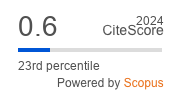Gender differences in left ventricular hypertrophy regression after renal denervation in patients with resistant hypertension
https://doi.org/10.29001/2073-8552-2019-34-4-128-135
Abstract
Purpose. To study the regression of left ventricular hypertrophy (LVH) in men and women with resistant hypertension (RH) after renal denervation (RDN).
Material and Methods. A total of 84 patients (50% men) with RH were enrolled in the study after signing informed consent. Renal denervation was performed in all patients. Initially and at 6 and 12 months after treatment, patients underwent careful examination. These analyses included office blood pressure (BP) measurement, transthoracic echocardiography (TTE) study with assessments of the left ventricular (LV) wall thickness and LV mass (LVM), and cardiac magnetic resonance (CMR) imaging.
Results. Groups of men and women were comparable in regard to office BP, age, number of administered antihypertensive drugs, and the number of radiofrequency energy applications for RDN. The LVM in the male group was significantly higher than in women due to anatomy differences. According to echocardiography data, the rate of LVH was insignificantly higher in women: 90% in women versus 76% in men, χ2 = 0.079. In the presence of a significant and comparable BP reduction, significant regression in the values interventricular wall thickness (by 4.4%, р=0.039) and LVM (by 9.5%, р=0.044) was found in men one year after RND according to data of echocardiography. According to CMR according to CMR, LVM decreased by 11.9% at six months (р=0.039) and by 22.9% at 12 months (р=0.026) after RND. However, no significant changes in LVM were found in women. The extent of LVM regression did not depend on the antihypertensive effect of RDN in either group.
Conclusion. The frequency of LVH was insignificantly higher in women than in men: 90% in women versus 76% in men. One year after RDN, LVH significantly regressed in men, but not in women, and did not depend on degree of BP reduction.
About the Authors
E. S. SitkovaRussian Federation
Ekaterina S. Sitkova - Cand. Sci. (Med.), Research Scientist, Department of Hypertension.
111a, Kievskaya str., Tomsk, 634012
V. F. Mordovin
Russian Federation
Viktor F. Mordovin - Dr. Sci. (Med.), Professor, Head of Department of Hypertension.
111a, Kievskaya str., Tomsk, 634012
T. M. Ripp
Russian Federation
Tatyana M. Ripp - Dr. Sci. (Med.), Leading Research Scientist, Department of Hypertension.
111a, Kievskaya str., Tomsk, 634012
S. E. Pekarskiy
Russian Federation
Stanislav E. Pekarskiy - Dr. Sci. (Med.), Leading Research Scientist, Department of Hypertension.
111a, Kievskaya str., Tomsk, 634012
T. R. Ryabova
Russian Federation
Tamara R. Ryabova - Cand. Sci. (Med.), Senior Research Scientist,
Department of Ultrasound and Functional Diagnostics.
111a, Kievskaya str., Tomsk, 634012
А. Yu. Falkovskaya
Russian Federation
Alla Yu. Falkovskaya - Cand. Sci. (Med.), Senior Research Scientist,
Department of Hypertension.
111a, Kievskaya str., Tomsk, 634012
V. A. Lichikaki
Russian Federation
Valeria A. Lichikaki - Cand. Sci. (Med.), Research Scientist, Department
of Hypertension.
111a, Kievskaya str., Tomsk, 634012
I. V. Zyubanova
Russian Federation
Irina V. Zyubanova - Cand. Sci. (Med.), Junior Research Scientist,
Department of Hypertension.
111a, Kievskaya str., Tomsk, 634012
A. E. Baev
Russian Federation
Andrey E. Baev - Cand. Sci. (Med.), Head of the Department of
Invasive Cardiology.
111a, Kievskaya str., Tomsk, 634012
O. V. Mochula
Russian Federation
Olga V. Mochula - Cand. Sci. (Med.), Junior Research Scientist,
Department of Radiology and Tomography.
111a, Kievskaya str., Tomsk, 634012
V. Yu. Usov
Russian Federation
Vladimir Yu. Usov - Dr. Sci. (Med.), Professor, Head of the Department
of Radiology and Tomography.
References
1. Liao Y, Cooper R.S., Mensah G.A., McGee D.L. Left ventricular hypertrophy has a greater impact on survival in women than in men. Circulation. 1995;92(4):805-810. DOI: 10.1161/01.cir.92.4.805.
2. Lee D.S., Gona P, Vasan R.S., Larson M.G., Benjamin E.J., Wang T.J. et al. Relation of disease pathogenesis and risk factors to heart failure with preserved or reduced ejection fraction: insights from the Framingham heart study of the national heart, lung, and blood institute. Circulation. 2009;119:3070-3077. DOI: 10.1161/CIRCULATIONAHA.108.815944.
3. Melenovsky V., Borlaug B.A., Rosen B., Hay I., Ferruci L., Morell C.H. et al. Cardiovascular features of heart failure with preserved ejection fraction versus nonfailing hypertensive left ventricular hypertrophy in the urban Baltimore community: the role of atrial remodeling/dys-function. J. Am. Coll. Cardiol. 2007;49(2):198-207. DOI: 10.1016/j. jacc.2006.08.050.
4. Vaid'ya R. Structural and functional changes of left ventricular in patients with arterial hypertension and effective antihypertensive treatment: Abstr. Dis. ... Cand. Med. Sci. Veliky Novgorod, 2004:20 (In Russ.).
5. Sitkova E.S., Mordovin V.F., Ripp T.M., Pekarskiy S.E., Ryabova T.P., Li-chikaki V.A. et al. Positive effects of renal denervation on left ventricular hypertrophy and subendocardial damage. Arterial Hypertension. 2019;25(1):46-59 (In Russ.). DOI: 10.18705/1607-419X-2019-25-1-46-59.
6. De Sousa Almeida M., de Araujo Gonsalves P, Branco P, Mesquita J., Carvalho M.S., Dores H. et al. Impact of renal sympathetic denervation on left ventricular structure and function at 1-year follow-up. PLoS One. 2016;11(3):e0149855. DOI: 10.1371/journal.pone.0149855.
7. Nio A.Q.X., Stohr E.J., Shave R.E. Age-related differences in left ventricular structure and function between healthy men and women. Climacteric. 2017;20(5):476-483. DOI: 10.1080/13697137.2017.1356814.
8. Conroy R.M., Pyorala K., Fitzgerald A.P, Sans S., Menoffi A., de Backer G. et al. Estimation of ten-year risk of fatal cardiovascular disease in Europe: the SCORE project. Eur. Heart J. 2003;24:987-1003. DOI: 10.1016/s0195-668x(03)00114-3.
9. Mancia G., Fagard R., Narkiewicz K., Redon J., Zancheffi A., Bohm M. et al. Guidelines 2013 ESH/ESC for the management of arterial hypertension: The Task Force for the management of arterial hypertension of the European Society of Hypertension (ESH) and of the Europea Society of Cardiology (ESC). J. Hypertens. 2013;31(7):1281-1357. DOI: 10.1097/01.hjh.0000431740.32696.cc.
10. Gerdts E., Izzo R., Mancusi C., Losi M.A., Manzi M.V, Canciello G. et al. Left ventricular hypertrophy offsets the sex difference in cardiovascular risk (the Campania Salute Network). Int. J. Cardiol. 2018;258:257-261. DOI: 10.1016/j.ijcard.2017.12.086.
11. Muiesan M.L., Paini A., Aggiusti C., Bertacchini F., Rosei C.A., Salveffi M. Hypertension and organ damage in women. High Blood Press. Car-diovasc. Prev. 2018;25(3):245-252. DOI: 10.1007/s40292-018-0265-0.
12. Regitz-Zagrosek V., Oertelt-Prigione S., Prescott E., Franconi F., Gerdts E., Foryst-Ludwig A. et al. Gender in cardiovascular diseases: impact on clinical manifestations, management, and outcomes. Eur. Heart J. 2016;37(1):24-34. DOI: 10.1093/eurheartj/ehv598.
13. Kostkiewicz M., Tracz W., Olszowska M., Podolec P., Drop D. Left ventricular geometry and function in patients with aortic stenosis: gender differences. Int. J. Cardiol. 1999;71:57-61. https://www.ncbi.nlm.nih.gov/pubmed/10522565.
14. Krumholz H.M., Larson M., Levy D. Sex differences in cardiac adaptation to isolated systolic hypertension. Am. J. Cardiol. 1993;72(3):310-313. DOI: 10.1016/0002-9149(93)90678-6.
15. Williams B., Mancia G., Spiering W. et al. 2018 ESC/ESH Guidelines for the management of arterial hypertension: The Task Force for the management of arterial hypertension of the European Society of Cardiology and the European Society of Hypertension. J. Hypertens. 2018;36(10):1953-2041. DOI: 10.1097/HJH.0000000000001940.
16. Lu H., Melendez G.C., Levick S.P., Janicki J.S. Prevention of adverse cardiac remodeling to volume overload in female rats is the result of an estrogen-altered mast cell phenotype. Am. J. Physiol. Heart Circ. Physiol. 2012;302(3):H811-817. DOI: 10.1152/ajpheart.00980. 2011.
17. Montalvo C., Villar A.V., Merino D., Garda R., Ares M., Llano M. et al. Androgens contribute to sex differences in myocardial remodeling under pressure overload by a mechanism involving TGF-p. PLoS One. 2012;7(4):e35635. DOI: 10.1371/journal.pone.0035635.
18. Gerdts E., Okin P.M., de Simone G., Cramariuc D., Wachtell K., Boman K. et al. Gender differences in left ventricular structure and function during antihypertensive treatment: the Losartan Intervention for Endpoint Reduction in Hypertension Study. Hypertension. 2008;51(4):1109-1114. DOI: 10.1161/HYPERTENSIONA-HA.107.107474.
19. Murdolo G., Angeli F., Reboldi G., Di Giacomo L., Aita A., Bartolini C. et al. Left ventricular hypertrophy and obesity: only a matter of fat?
Review
For citations:
Sitkova E.S., Mordovin V.F., Ripp T.M., Pekarskiy S.E., Ryabova T.R., Falkovskaya А.Yu., Lichikaki V.A., Zyubanova I.V., Baev A.E., Mochula O.V., Usov V.Yu. Gender differences in left ventricular hypertrophy regression after renal denervation in patients with resistant hypertension. Siberian Journal of Clinical and Experimental Medicine. 2019;34(4):128-135. (In Russ.) https://doi.org/10.29001/2073-8552-2019-34-4-128-135





.png)





























